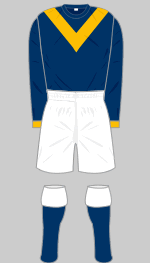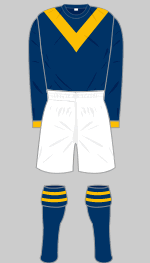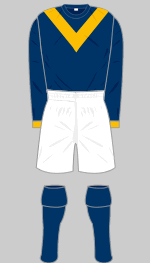Leeds City
Formed 1904. Wound up by FA order 1919.
Elected to Division Two 1905. Expelled 1919.
Kit History
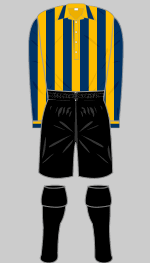
1904-1905 g
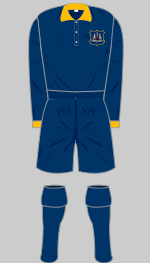
1905-1906 f
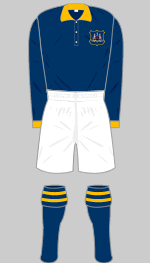
1906-1908 a d f
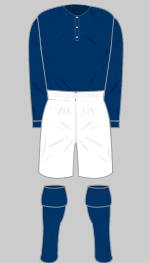
1908-1909 h
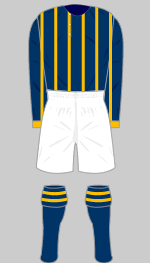
1909-1911 a d e h
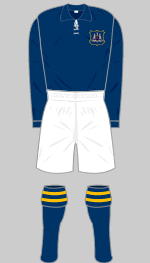
1911-1912 e f
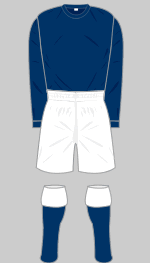
1912-1913 f
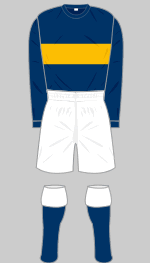
Sept-Dec? 1913 c f
Background
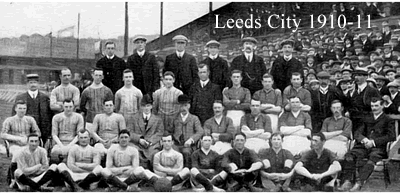 The rapid rise and fall of
Leeds City is as dramatic as any in the game. Formed by a group of local
notables at a meeting in the Griffin Hotel, the idea was to bring professional
football to one of the rugby strongholds of Yorkshire's West Riding. During their inaugural
season, the club frequently fielded their reserves in the West Yorkshire
League while the first team turned out against League opposition in friendly
matches. After cultivating the top clubs in this way, City were rewarded
with election to an expanded Division Two the following season.
The rapid rise and fall of
Leeds City is as dramatic as any in the game. Formed by a group of local
notables at a meeting in the Griffin Hotel, the idea was to bring professional
football to one of the rugby strongholds of Yorkshire's West Riding. During their inaugural
season, the club frequently fielded their reserves in the West Yorkshire
League while the first team turned out against League opposition in friendly
matches. After cultivating the top clubs in this way, City were rewarded
with election to an expanded Division Two the following season.
Wearing dark blue with old gold trim, City had
an undistinguished career in the Second Division. The team wore the city's coat of arms on their shirts in their  first few seasons but this appears to have been dropped when striped jerseys were introduced in 1908.
first few seasons but this appears to have been dropped when striped jerseys were introduced in 1908.
Recent research (March 2010) by Dave Tomlinson has revealed that in the 1910-11 season, City adopted green change shirts after they signed five young and inexperienced Irish players to the first team. The Leeds Mercury reported, on 5 September 1910, It must be remembered that these Irishmen are very young men, who have been brought into a higher class of football than that to which they have been accustomed, and that they were playing their first match amid unfamiliar surroundings. Mr Scott-Walford evidently had an eye to making his new men feel at home as well as to stage effect when he attired the team in green jerseys and supplied green flags to mark the centre line, and he apparently realised that the first match might go wrong when he thus addressed them in his official programme: “Should your efforts deserve success, and it is denied you, we shall extend our sympathy, when you do badly we shall still think you have done your best.” The unfamiliar tops may be seen in the photograph above, worn by the reserves.
In 1912, Herbert Chapman was appointed manager. Had the First World War not interrupted proceedings, who knows what the great man would have achieved at City?
In the 1913-14 season the team started out wearing the navy jerseys with a broad gold band but by December thay had switched to wearing a large chevron. This would be their signature strip until the club was disbanded.
In the season immediately after the Great War, Chapman was rebuilding his side when a disgruntled former player made allegations in the press that guest players had been paid during during wartime competition. The practice was widespread but was a serious breach of FA rules. The joint FA and Football League commission set up to investigate demanded that City open their accounts. When the club refused the commission ordered that Leeds City be expelled from the League and disbanded to set an example.
With eight games of the new season already played, Burslem Port Vale (who had narrowly missed out on election to the League the previous close-season) were invited to take over Leeds' fixtures. Five officials, including Chapman, were banned from involvement in football for life. Chapman's punishment was overturned on appeal and he went on to immortal achievements with Huddersfield and Arsenal.
On 17 October 1919 the club's assets were sold off and that same afternoon a group of "untainted" officials formed a new club, Leeds United. United took over Leeds City reserves' fixtures in the Midland League and moved into the now vacant Elland Road. The following season the brand new club was elected to the Football League.
Sources
- (a) The Mighty Mighty Whites An excellent site with a detailed history of both City and United compiled by Dave Tomlinson
- (b) "Of Fossils & Foxes: The Official History of Leicester City FC" 2001
- (c) "Rejected FC" (Dave Twydell 1989) - information provided by Ralph Pomeroy.
- (d) Association of Football Statisticians - provided by Pete Wyatt
- (e) Dave Tomlinson
- (f) Keith Ellis (HFK Research Associate
- (g) Jonathon Auty
- (h) Leeds History
